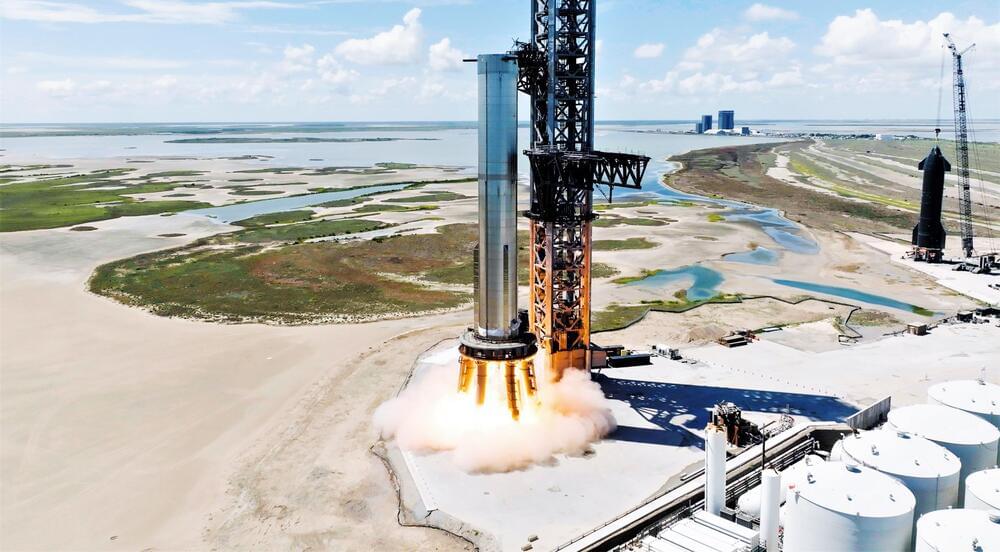Circa 2016 face_with_colon_three
Imagine if we could get to Mars in 40 days instead of seven months! It could happen if we used plasma rockets, which travel at 34 miles per second. But how do we make this a reality?
Circa 2016 face_with_colon_three
Imagine if we could get to Mars in 40 days instead of seven months! It could happen if we used plasma rockets, which travel at 34 miles per second. But how do we make this a reality?

SpaceX has completed a record-breaking test of a Starship booster and rolled a newer Super Heavy prototype to the launch pad just hours apart.
Almost six weeks after SpaceX began Super Heavy Booster 7’s static fire test campaign, the company has broken new ground by simultaneously igniting seven Raptor engines at once. A matter of hours later, confirming SpaceX CEO Elon Musk’s plans in real time, the company transported a second Super Heavy prototype (Booster 8) from the factory to the launch pad, where it joined Booster 7.
According to Musk, those rockets will soon switch places, ensuring that no time is wasted while SpaceX continues to gradually work towards Starship’s first orbital launch attempts.
SUSIE’s vertical landing capabilities draw comparisons to SpaceX’s Starship. Europe’s not quite there yet, but it’s a step in the right direction.
French aerospace giant ArianeGroup revealed a new concept for a reusable upper-stage spacecraft called Smart Upper Stage for Innovative Exploration, or SUSIE.
The spacecraft will be able to carry heavy payloads as well as crewed missions to orbit before coming down to Earth for a vertical landing, a press statement reveals.

Elon Musk said the “next big test” is likely a full stack wet dress rehearsal of Starship.
SpaceX’s massive Starship rocket continues to pass key tests on its road to sending the Mars-bound launch system up to orbit for the first time.
The private space firm fired seven Raptor engines on its Starship Super Heavy prototype, called Booster 7, on Monday, September 19. As Space.com points out, it is the highest number of next-generation engines ever tested simultaneously.

Artificial gravity is the new black.
Vast, a California-based startup, has revealed that the company will develop artificial-gravity space stations to enhance human productivity in space. With a team of exceptional engineers, industry experts, k and an aerospace engineer and former vice president at SpaceX, Hans Koenigsmann, the company aims to create a setting where people can live as well as work in space.
The solar system has an incredible amount of resources.
3DSculptor/iStock.
Vast’s mission is to enable a future where millions of people are living across the solar system, said Jed McCaleb, who worked on projects such as Stellar, the Astera Institute, Ripple, and eDonkey2000.


It could support non-combat activities such as humanitarian relief operations and medical missions.
Commercial space company Sierra Space, which is developing the shuttle-shaped Dream Chaser spacecraft for transportation solutions, has signed an agreement with the U.S. Department of Defense (DOD) transportation command for point-to-point global terrestrial delivery of military materiel and personnel.
Both organizations will develop solutions using the Dream Chaser spaceplanes, Shooting Star cargo modules, and on-orbit infrastructure that provides unique capabilities for precise, cost-effective, and timely global delivery of Department of Defense logistics and personnel through space.
The company’s developing a rocket reuse method that uses helicopters to pluck boosters out of the sky.
Rocket Lab, the company that’s building the technology to pluck first-stage rocket boosters out of the sky for reuse, reached a new reusability milestone, a press statement from the company earlier this month confirmed.
For the first time, the company fired up a Rutherford engine from one of its Electron boosters that had been recovered after flying to space.
Plentiful, safe, energy that burns up nuclear waste as fuel could be provided as soon as we build these reactor, There is no excuse for us freezing this winter! Watch and learn. Share widely to get the word out!
Worm-hole generators by the pound mass: https://greengregs.com/
For gardening in your Lunar habitat GalacticGregs has teamed up with True Leaf Market to bring you a great selection of seed for your planting. Check it out: http://www.pntrac.com/t/TUJGRklGSkJGTU1IS0hCRkpIRk1K
Awesome deals for long term food supplies for those long missions to deep space (or prepping in case your spaceship crashes: See the Special Deals at My Patriot Supply: www.PrepWithGreg.com.
Thankfully, no crew were onboard for what would have been a terrifying ride.
One minute and four seconds after the launch of an uncrewed flight of Blue Origin’s New Shepard launch system on Monday, September 12, the rocket suffered an anomaly.
Explosive footage shows the New Shepard capsule’s solid rocket escape system fire up to safely eject the capsule away from the rocket’s first stage.